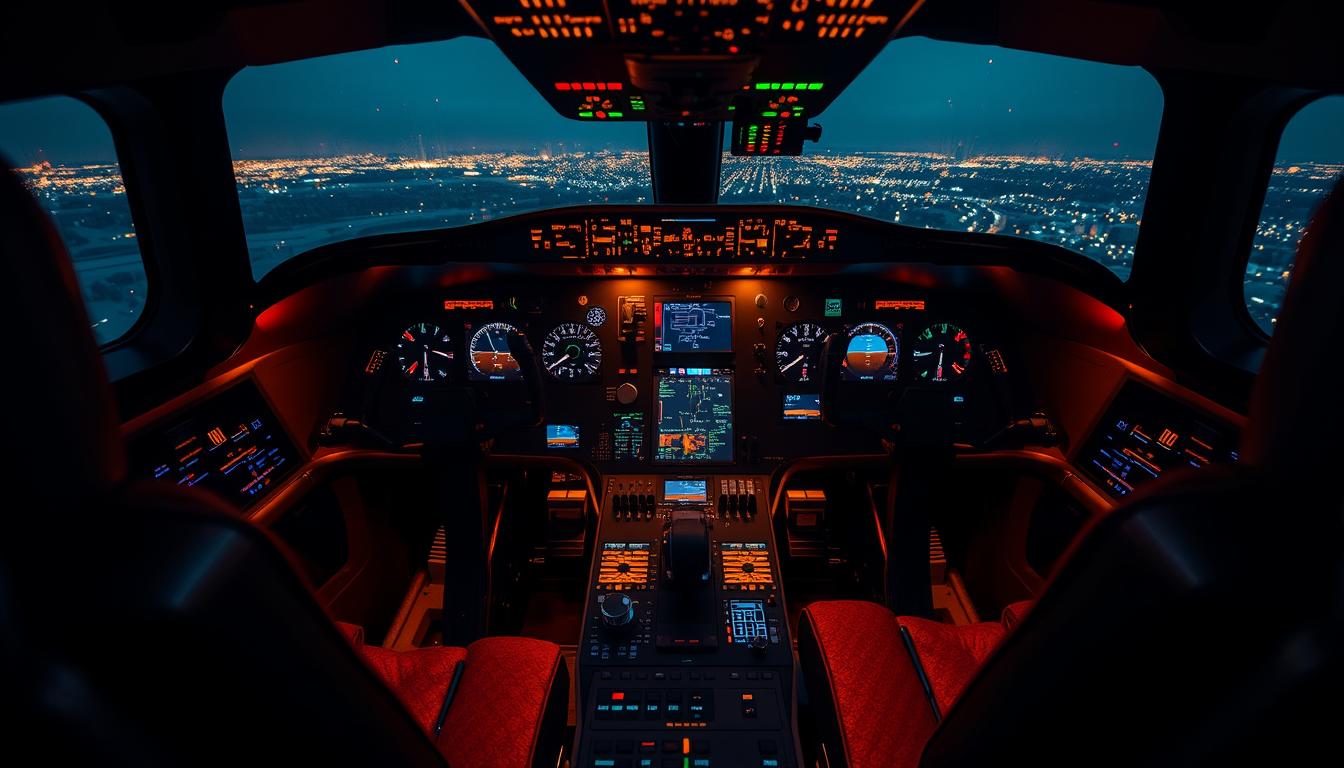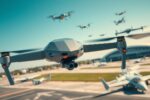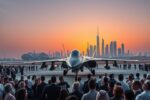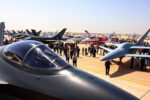You are about to explore the intricacies of the cockpit design in modern aviation. The pilot area is a complex system that requires precision and attention to detail.
pilot area front view
The dashboard in the front view is a critical component. It provides pilots with essential information for safe flight operations. As you explore aviation, understanding the cockpit’s layout and functionality is key.
Key Takeaways
- The cockpit design plays a vital role in aviation safety.
- Modern cockpits are equipped with advanced technology.
- The dashboard layout is critical for pilot decision-making.
- Aviation professionals must understand cockpit functionality.
- The design of the cockpit impacts pilot performance.
The Anatomy of a Modern Cockpit
Exploring a modern cockpit reveals its essential parts and layout. It’s a high-tech space that blends new tech with classic flight tools. This mix helps pilots fly safely and efficiently.
modern cockpit components
Key Components at First Glance
At first, the cockpit looks like a maze of gadgets and controls. Primary flight displays and navigation systems stand out, giving pilots key info. The glass cockpit uses digital screens instead of old-fashioned gauges. This makes things clearer and eases the pilot’s job.
The cockpit has many systems, like flight computers, autopilot, and comms gear. These work together to give a full picture of the plane and its environment.
The Pilot’s Workspace Layout
The pilot’s area is set up for quick work and less distraction. Important flight info is easy to see, and controls are within reach. The pilot’s seat and control yoke or sidestick are comfy for long hours.
The cockpit’s design also helps pilots work together well. In planes needing two pilots, everything is close to both, making teamwork easier.
Evolution of Cockpit Design Through Aviation History
The story of cockpit design is truly fascinating. It has changed a lot over time. This change is due to new technology and the needs of pilots.
The early days of aviation saw simple, rudimentary cockpits with basic controls and minimal instrumentation. As aircraft became more complex, so did their cockpits. New technologies led to more advanced systems, making way for today’s glass cockpits.
From Basic Controls to Glass Cockpits
The move from old analog instruments to glass cockpits was a big step. Glass cockpits, with their digital displays and multifunction screens, are now common. This change has made flying safer and easier for pilots.
Aviation experts say, “Glass cockpits have changed how pilots work with their planes. They make flying safer and more efficient.”
cockpit evolution
Standardization of Cockpit Layouts
Standardizing cockpit layouts has been key. It makes training pilots faster and safer. With similar layouts, pilots can easily switch between planes, reducing confusion in emergencies.
Standardization efforts have streamlined pilot training. This consistency helps pilots focus on flying, not adjusting to different cockpits. It’s a big part of safe flying in complex aircraft.
Understanding the Pilot Area Front View
When you look at the pilot area front view, you see many instruments and displays. This area is key for pilots. It gives them the info they need for safe flying.
Primary Flight Displays
Primary flight displays are a big part of the pilot area. They show pilots important flight details like altitude and airspeed. Today’s displays are digital, making it easy to read the info, even when it’s hard to see.
Navigation Systems and Radar Displays
Navigation systems and radar displays are also important. They help pilots know where they are and where they’re going. Radar shows weather and other planes nearby. These tools make flying safer and smoother.
Engine and System Monitoring Instruments
Engine and system monitoring instruments are essential. They watch over the aircraft’s health and performance. By checking these, pilots can spot problems early. This keeps the plane safe to fly.
Pilot Seating Configuration and Ergonomics
Your pilot seating setup is more than just comfort. It’s about being in the best position for safe flying. The way your seat is set up can really affect how well you can control the plane.
Seat Design and Adjustment Features
The pilot seat is designed with many adjustments. These are key for fitting different body types and preferences. They help you get into a comfy position that lets you control the plane well.
Lumbar Support and Comfort Features
Lumbar support is very important in the pilot seat. It helps your back during long flights. Features like cushioning and adjustable armrests also make flying more comfortable, helping to prevent fatigue.
Safety Harness Systems
Safety harness systems are a big part of the pilot seat. They keep the pilot safe during bumpy flights or emergencies. These systems usually have lap belts and shoulder harnesses.
Optimal Positioning for Flight Control
Getting into the right position in the pilot seat is key for flying well. You need to adjust the seat height, tilt, and lumbar support. This lets you easily reach all controls and see the instruments clearly.
- Adjust the seat height to allow for a slight bend in the knees.
- Position the seat tilt to support your back and promote good posture.
- Use lumbar support to maintain the natural curve of your lower back.
By paying attention to these parts of pilot seating, you can feel more comfortable and in control while flying. This makes flying safer and more efficient.
The Flight Instrument Panel Explained
For any pilot, understanding the flight instrument panel is key. It’s right in front of the pilots and holds all the necessary tools for flying. This panel is filled with displays and controls that give pilots the info they need to fly safely.
The Six Primary Flight Instruments
The primary flight instruments are at the heart of the panel. They give pilots the vital data they need to control and navigate the aircraft. These instruments are essential for keeping the aircraft on course.
Attitude and Heading Indicators
The attitude indicator shows how the aircraft is positioned relative to the horizon. The heading indicator tells pilots the aircraft’s direction. Together, they help pilots stay aware of their surroundings and navigate through different flight conditions.
Airspeed and Altitude Instruments
The airspeed indicator shows the aircraft’s speed compared to the air. The altimeter tells pilots how high the aircraft is above sea level. These instruments are critical for safe flying.
Secondary Instruments and Their Functions
The flight instrument panel also has secondary instruments. These provide extra information pilots need to manage the flight.
Engine Gauges and System Indicators
Engine gauges keep an eye on the aircraft’s engines. They show things like RPM, oil pressure, and temperature. These gauges help pilots spot engine problems early.
Weather Radar and Terrain Awareness Systems
Weather radar systems help pilots avoid bad weather. Terrain awareness systems warn pilots about possible collisions with terrain. These systems improve safety by giving pilots early warnings of dangers.
Control Yokes and Steering Systems
Control yokes and steering systems are key in the cockpit. They help pilots steer the aircraft with great precision. These systems have changed a lot, from old mechanical setups to new fly-by-wire tech.
Traditional Yoke Systems
For many years, traditional yoke systems have been the main way to control aircraft. They use a mechanical link between the yoke and the aircraft’s control surfaces.
Boeing Control Column Design
Boeing’s control column is a classic example of a traditional yoke system. It has a strong column with the control yoke inside. This design makes it easy and safe for pilots to use.
Control Force Feedback Mechanisms
Control force feedback is key in traditional yoke systems. It gives pilots a feel of the aircraft’s movements. This feedback helps pilots control the plane better and stay aware of their surroundings.
Sidestick Controllers in Modern Aircraft
Sidestick controllers are now more common, mainly in fly-by-wire systems. They are used in modern aircraft.
Airbus Fly-by-Wire Philosophy
Airbus’s fly-by-wire system has changed how pilots control the aircraft. It uses electronic signals to control the surfaces. This makes flying safer and easier for pilots.
Advantages and Limitations
Sidestick controllers have many benefits, like being lighter and more reliable. But, they also have downsides. Some pilots miss the feel of the old systems.
| Feature | Traditional Yoke | Sidestick Controller |
| Mechanical Linkage | Yes | No |
| Fly-by-Wire | No | Yes |
| Tactile Feedback | Yes | Limited |
As technology keeps improving, control yokes and steering systems will likely change too. New fly-by-wire and digital tech will play a big role in these changes.
Avionics Systems in the Modern Cockpit
Advanced avionics systems are key to modern cockpits, helping pilots make better decisions. These systems have changed how pilots work with the aircraft. Now, flying is safer and more efficient.
The modern cockpit has many advanced avionics. You’ll find glass cockpit displays, flight management systems, and top-notch communication and navigation tools. Together, they give pilots a full view of the aircraft’s status and its surroundings.
Glass Cockpit Displays
Glass cockpit displays have replaced old analog instruments with digital screens. This makes the interface more flexible and customizable. These screens can show lots of information, like flight data and navigation charts, and can be adjusted for different flight phases.
Flight Management Systems
Flight management systems (FMS) are vital for navigating and planning flights. They let pilots enter flight plans, navigate through waypoints, and find the most efficient flight path. Today’s FMS are very advanced, using data from many sources for accurate navigation.
Communication and Navigation Equipment
Good communication and navigation are key for safe flying. Modern cockpits have advanced communication tools, like radios and data link communications. They also have navigation gear, such as GPS and terrain awareness systems.
| Avionics Component | Function | Benefits |
| Glass Cockpit Displays | Digital display of flight data and navigation information | Improved situational awareness, customizable interface |
| Flight Management Systems | Navigation and flight planning | Optimized flight paths, reduced pilot workload |
| Communication Equipment | Radio and data link communications | Enhanced communication with air traffic control, reduced misunderstandings |
In conclusion, avionics systems are essential in modern cockpits. They improve navigation, communication, and aircraft management. As technology gets better, we’ll see even safer and more efficient flying.
Cockpit Variations Across Aircraft Types
Exploring aviation, you’ll see cockpits vary a lot. The cockpit, or flight deck, is the aircraft’s control center. Its design meets the aircraft’s specific needs.
Commercial Airliners vs. Private Jets
Commercial airliners and private jets have different cockpit designs. Airliners focus on safety and efficiency for many passengers. Private jets aim for luxury and flexibility for fewer passengers.
Wide-Body vs. Narrow-Body Configurations
Wide-body airliners have complex cockpits due to their size. They need advanced systems for large crews and passengers. Narrow-body planes have simpler cockpits.
Business Jet Cockpit Innovations
Business jets have advanced avionics and designs for better pilot comfort. They often include glass cockpits and flight management systems.
Helicopter Cockpit Configurations
Helicopter cockpits are designed for rotary-wing flight. They have unique controls like collective and cyclic.
Collective and Cyclic Controls
The collective and cyclic controls are key for helicopters. They let pilots adjust the rotor blades’ pitch and the helicopter’s direction.
Single vs. Dual Pilot Operations
Helicopters can have one or two pilots. Dual pilot operations are common in complex helicopters. This setup improves safety by sharing the workload.
Cockpit designs vary greatly among aircraft, from airliners to helicopters. Knowing these differences helps us understand aviation’s complexity.
Safety Features in the Pilot Area
The pilot area has advanced safety features to keep pilots and planes safe. These features are key in emergencies, giving pilots the tools they need to act fast.
Emergency Controls and Indicators
Emergency controls and indicators are essential in the pilot area. They alert pilots to problems and help them take quick action. This includes warning lights, sounds, and control panels for emergency systems.
Fire Suppression Systems
Fire suppression systems are vital for putting out fires in engines or cabins. Pilots can turn them on manually or they can go off automatically if they sense heat or flames.
Emergency Electrical Controls
Emergency electrical controls let pilots manage power in emergencies. They can cut off bad systems and switch to backup power to keep important functions going.
Redundancy Systems and Backup Instruments
Redundancy systems and backup instruments keep key functions working even if main systems fail. This is essential for keeping pilots in control and the plane safe.
Mechanical Backup Instruments
Mechanical backup instruments are a backup for when electronic ones fail. These devices, like standby attitude indicators, work on their own, not with the main electronic systems.
Alternate Power Sources
Alternate power sources, like backup generators and batteries, keep important systems running when there’s a power loss. They turn on automatically or by pilot command as needed.
| Safety Feature | Description | Functionality |
| Fire Suppression Systems | Designed to extinguish fires in engine or cabin areas. | Manual or automatic activation. |
| Emergency Electrical Controls | Manage electrical power distribution during emergencies. | Isolate faulty systems, switch to backup power. |
| Mechanical Backup Instruments | Provide failsafe for electronic instrument failures. | Operate independently of primary electronic systems. |
| Alternate Power Sources | Ensure essential systems remain powered during electrical failures. | Automatic or manual activation. |
The Co-Pilot’s Station and Crew Coordination
In today’s cockpits, the co-pilot’s station is key for crew coordination and safety. The co-pilot supports the pilot, making a strong team. Together, they ensure the aircraft operates well.
Shared Controls and Responsibilities
The co-pilot has their own controls and instruments. This lets them help with flying. Shared responsibilities include watching flight instruments, handling tough weather, and talking to air traffic control.
Crew Resource Management in the Cockpit
Crew Resource Management (CRM) is vital in flying today. It’s about using all resources well for safe and efficient flights. CRM includes how crew talks and tasks are given during important flight times.
Communication Protocols
Good communication is at the heart of CRM. Clear, simple communication rules help the pilot and co-pilot talk well. This lowers the chance of mistakes that could be dangerous.
Task Distribution During Critical Phases
In key flight times like takeoff and landing, tasks are split. This helps the crew work better and safely. It lets them focus on what’s important.
| Task | Pilot Responsibility | Co-Pilot Responsibility |
| Monitoring Flight Instruments | Primary | Secondary |
| Navigation | Secondary | Primary |
| Communication with ATC | Primary | Secondary |
Future Trends in Cockpit Design
New technologies are changing the cockpit. Soon, pilots will see big changes in how they work with their planes.
Augmented Reality Displays
Augmented reality (AR) displays are coming to cockpits. AR mixes digital info with the real world. This makes it easier for pilots to understand their surroundings.
It can make flying safer and less stressful. This is a big step forward.
Artificial Intelligence Integration
Artificial intelligence (AI) is being added to cockpits. AI can do routine tasks and even help pilots make decisions. This could make flying more efficient and reduce pilot tiredness.
Single-Pilot Operations Technology
Single-pilot operations technology is also being developed. It lets one pilot run the plane with the help of AI and automation. This could change how airlines work and save money.
| Trend | Description | Potential Impact |
| Augmented Reality Displays | Overlays digital information onto the real world | Enhanced situational awareness, reduced pilot workload |
| Artificial Intelligence Integration | Automates routine tasks, provides predictive maintenance | Increased efficiency, reduced pilot fatigue |
| Single-Pilot Operations Technology | Enables safe operation by a single pilot with automation | Potential cost savings, changed flight operation dynamics |
Conclusion: The Pilot’s Command Center
You now know a lot about cockpit design and its importance. It’s the pilot’s command center. The cockpit gives pilots the tools they need to fly safely.
The pilot area’s seating and dashboard are key. They offer a central spot for controls and instruments. Modern cockpits use advanced systems like glass displays and flight management systems. These help pilots make better decisions.
Knowing how the cockpit works helps us understand the pilot’s role. It’s important for safe and efficient flying. As flying technology gets better, so will cockpit design. This will help pilots do their job better and keep flying safe.
FAQ
What is the primary function of the pilot area seating dashboard front view?
The main job is to give pilots a full view of the aircraft’s status. This includes navigation, engine performance, and other key systems.
How has cockpit design evolved over the years?
Cockpit design has changed a lot. It moved from simple mechanical controls to advanced glass cockpits with digital displays.
What are the key components of a modern cockpit?
Modern cockpits have primary flight displays, navigation systems, and radar displays. They also have engine monitoring instruments and control yokes or sidestick controllers.
What is the significance of pilot seating configuration and ergonomics?
The right pilot seating and ergonomics are key. They help pilots stay comfortable, reduce fatigue, and control the flight better.
How do avionics systems enhance flight operations?
Avionics systems, like glass cockpit displays and flight management systems, help pilots. They provide accurate info, improve awareness, and make decisions easier.
What are the differences between Boeing and Airbus cockpit designs?
Boeing and Airbus have different cockpit designs. Boeing uses a control column, while Airbus has sidestick controllers and fly-by-wire technology.
What safety features are integrated into the pilot area?
Safety features include emergency controls and indicators, fire suppression systems, and backup instruments. They ensure pilot safety and aircraft survival in emergencies.
How do crew coordination and resource management impact flight safety?
Good crew coordination and resource management are vital for safety. They help pilots work well together, share tasks, and make smart decisions during flight.
What future trends are shaping cockpit design?
New trends include augmented reality displays, artificial intelligence, and single-pilot operations technology. These will change how cockpits work and how pilots interact with them.
How do different aircraft types vary in cockpit design?
Cockpit designs differ among commercial airliners, private jets, and helicopters. Each type has its own needs and design approach.







